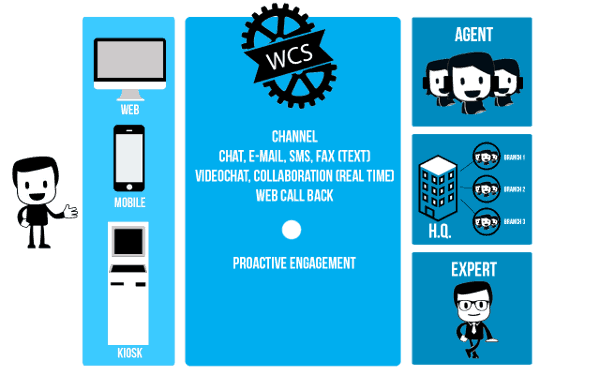Tracking customer journeys.
There’s a consensus of sorts that WebRTC will make its way into contact centers. One of the interesting vendors in this space is Eudata.
 Eudata is all about customer journeys – understanding how are customers interacting with the enterprise, and facilitating these interactions. Sandro Parisi, CEO of Eudata, took me through their platform and how they use WebRTC as part of their offering.
Eudata is all about customer journeys – understanding how are customers interacting with the enterprise, and facilitating these interactions. Sandro Parisi, CEO of Eudata, took me through their platform and how they use WebRTC as part of their offering.
What is Eudata all about?
Eudata is a company focused on making clients happy providing a great experience while their dealing with businesses.
The key fact is that If you are a digital customer and you interact with businesses today, you are probably part of the 60% unsatisfied about their customer experience. So in a fast evolving market as the one we daily face, being aligned with customer expectations is no more a nice to have for enterprises but a key point for their success.
This is why Eudata solution has a role in each step of the customer interaction, from customer engagement and profiling, to the communication itself and the possible follow up flows inside the company. We are not only a communication engine or a simple gateway, but also a platform where enterprises can map their business rules and flows on top of their organizations and their customer base.
To do this, flexibility is our mantra. We provide a core platform, capable to address several and distinct contact flows that can be designed configuring the services and designing the touchpoints with our APIs. I give you an example. If a customer access a specific service from a web page or from a mobile APP, the front end could be different, and it is different in the way to retrieve customer’s details, but the experience for the customer has to be absolutely the same as the company is behind the scenes!
I also want to stress another topic. As companies are digitally evolving, their way to interact is evolving together with the customer expectations. It is not only a matter of customer service, because a large number of enterprises are opening new services to be reached by online customers providing virtual access to physical shops, agencies or branches. It is clear that having a platform that leverages these kind of communication flows and permits to define business rules on top is an accelerator for them.
These are some of the reasons why we were mentioned as a Gartner cool vendor in CRM Customer Service and Support space in 2014.

What role does WebRTC play in your omnichannel offering?
WebRTC is disrupting the real time communication market, with impacts in how Telco companies will do business. Once mature, it will become a part of the infrastructure, so services built on top will be the real value.
This is why WebRTC is one of the key components of our strategy: provide enhanced customer journeys to digital clients permitting to set up audio/video sessions without plugins or clients that are not acceptable on customer’s side.
As we deal with large enterprises, a common task is the integration with their communication technologies. We provide standard connectors for the most common contact center, SIP PBX or presence servers, in order to address both a “simple” communication flow and data that we receive from web portals or from mobile APPs. With those integrations and the usage of a single “front end” technology like Eudata, Enterprises can realize different customer journeys, passing from the contact center to the branch in a click, without losing any detail about the conversation or any other attached information. All of that together with the asynchronous channels handling (Email, fax, SMS), permits our customer to be completely flexible.
You offer Flash fallback on IE and Safari. How did you come about doing that? Most vendors either skip IE and Safari or go for a WebRTC plugin.
Our customers are focused in delivering the best customer experience they can to their clients. From their point of view, they cannot accept that customers with Internet Explorer receive different experiences from ones with chrome. That’s why we’ve decided to keep Adobe Flash to provide 100% browser support, the only technology that offers a similar experience to the one provided by WebRTC. We invested a lot on this approach and the quality of our Audio/Video engine is great.
We decided to have a higher complexity on product side to keep it easier on customer side without any plugin or download required.
What signaling have you decided to integrate on top of WebRTC?
At the moment we’ve decided to keep an application signalling based on XMPP as our application server uses XMPP as communication protocol. It’s a lightweight version of Jingle. We decided not to go on with JsSIP or similar as we’re approaching WebRTC and Flash on an application level and not on an infrastructure level. We then have a gateway that is converting application requests into SIP.
Backend. What technologies and architecture are you using there?
We have a TURN/STUN server in front with a WebRTC and Flash Gateway in frontend and an application server in backend. We scale up linearly and we support balancer with sticky sessions for replication.
Where do you see WebRTC going in 2-5 years?
WebRTC, once standardized and adopted by Microsoft and hopefully also by Apple, will become the communication technology on customer side. WebRTC will disrupt the Telco business, reducing the importance of PSTN and the value of the devices.
On Enterprise side, it will be the preferred way to interact with customers. WebRTC will be used for customer care interactions, as well as for the interactions with experts or personal advisors. Using web to communicate it’s not only a matter of voice communication on a browser, but the chance to offer a richer service, with collaboration tools, information and data.
If you had one piece of advice for those thinking of adopting WebRTC, what would it be?
Before adopting a technology think of the business cases and the users you’re trying to reach. WebRTC is a brand new technology, so there are things that need to be enhanced, like browser or mobile devices support. We designed the platform with this in mind, solving the possible issues mixing it with alternative technologies until the technology will be mature enough. We think this is the best way to provide a unique experience to all the customers.
Given the opportunity, what would you change in WebRTC?
A better level of communication between big brands like Cisco, Google and Microsoft to have a more stable standardized and widely adopted standard. Another related topic is the enterprise adoption of the WebRTC standard requiring UDP protocol to be opened from internet and a lack of WebRTC firewall offering in the market.
What’s next for Eudata?
The technology enhancement of the platform is one of our historical priorities, creating new connectors to legacy CRM/Call Center Technologies, new analytics and optimizations, but actually our main effort is in enhancing the customer journey. To do this we are mapping into the platform several wizards and configuration tools that help enterprises design the cross channel processes they want without doing too many activities. The business value of the solution will be the key differential point our customers have to bear in mind to decide which technology is the most appropriate for their needs. We want to be ready and the best possible choice for that.
–
The interviews are intended to give different viewpoints than my own – you can read more WebRTC interviews.
